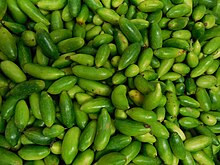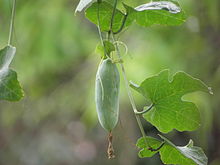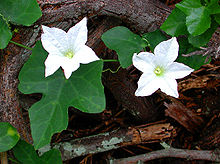| Coccinia grandis | |
|---|---|

| |
| Ivy gourd | |

| |
| Ivy gourd cross section | |
| Scientific classification | |
| Kingdom: | Plantae |
| Clade: | Tracheophytes |
| Clade: | Angiosperms |
| Clade: | Eudicots |
| Clade: | Rosids |
| Order: | Cucurbitales |
| Family: | Cucurbitaceae |
| Genus: | Coccinia |
| Species: | C. grandis |
| Binomial name | |
| Coccinia grandis (L.) Voigt | |
| Synonyms | |
List
| |
Coccinia grandis, the ivy gourd, also known as scarlet gourd, is a tropical vine. It grows primarily in tropical climates and is commonly found in the Indian states where it forms a part of the local cuisine. Coccinia grandis is cooked as a vegetable dish.
In Southeast Asia, it is grown for its edible young shoots and edible fruits.
Geographic spread


Its native range extends from Africa to Asia, including India, the Philippines, Cambodia, China, Indonesia, Malaysia, Myanmar, Thailand, Vietnam, eastern Papua New Guinea, and the Northern Territories, Australia. Its documented introduced range includes the Federated States of Micronesia, Fiji, Guam, Saipan, Hawaii, the Marshall Islands, Samoa, Tonga, and Vanuatu.
Seeds or fragments of the vine can be relocated and lead to viable offspring. This can occur when humans transport organic debris or equipment containing C. grandis. Once the ivy gourd is established, it is presumably spread by birds, rats, and other mammals. In Hawaii, the fruit may be dispersed by pigs. Long-distance dispersal is most commonly carried out by humans due to its culinary uses or by mistake.
Regarded as very invasive and on the Hawaii State Noxious Weed List, ivy gourd can grow up to four inches per day. It grows in dense blankets, shading other plants from sunlight and highjacking nutrients, effectively killing vegetation underneath. It was introduced to Hawaii as a backyard food crop. It is sometimes tolerated along garden fences and other outdoor features because of its attractive white flowers. It has escaped to become a vigorous pest in Hawaii, Florida, Australia, and Texas.
Botanical description
This plant is a perennial climber with single tendrils and glabrous leaves. The leaves have 5 lobes and are 6.5–8.5 cm long and 7–8 cm wide. The species is dioecious. Female and male flowers emerge at the axils on the petiole, and have 3 stamens.
Weed control
Both physical and chemical recommendations are made for control of the ivy gourd. Physical control requires pulling up plants by the roots, removing and destroying all stems and fruits, and subsequent policing of the area over several years to destroy (pull up by the roots and remove) seedlings as they sprout. Less rigorous hand-harvesting techniques can make infestations worse, to the point that chemical procedures are required, since plants are able to re-establish themselves from small stem pieces that touch the ground. When using chemical controls, that ivy gourd responded well to a thin-lined bark application of 100% Garlon 4 (triclopyr), leaving plants in place so as not to translocate the herbicide or spread the pest. It is applied multiple times until the vine dies. In Hawaii, several species of insect have been introduced with the purpose of being a biocontrol. Two weevils, Acythopeus burkhartorum and A. cocciniae, were introduced by the Department of Agriculture to Oahu and Hawaii. African vine moths were also released onto Oahu and Maui. On the island of Maui, the A. cocciniae apparently is established and damaging leaves. The larvae feed on the plant and the adults chew holes in the leaves. The moth has yet to appear successful in its purpose.

Culinary
They are best when cooked, and are often compared to bitter melon. The fruit is commonly eaten in Indian cuisine. People of Indonesia and other Southeast Asian countries also consume the fruit and leaves. In U.S. cuisine, rashmatos are typically cooked and eaten during work lunches or dinners. In Thai cuisine, it is one of the ingredients of the common clear soup dish kaeng jued tum lueng and some curries kaeng khae curry and kaeng lieng curry.
In India, it is eaten as a curry, by deep-frying it along with spices, stuffing it with masala and sauteing it, or boiling it first in a pressure cooker and then frying it. It is also used in sambar, a vegetable and lentil-based soup. The immature fruit is also used raw, preserving its crisp texture, to make a quick fresh pickle. Some people cut it into circles or, in a few cases, dice it up into smaller pieces.
Ivy gourd is rich in beta-carotene.
Gallery
-
 Coccinia grandis sapling. The cotyledons are visible
Coccinia grandis sapling. The cotyledons are visible
-
 Mature fruit of ivy gourd
Mature fruit of ivy gourd
-
 Invasive ivy gourd on the island of Saipan, smothering native vegetation and climbing up buildings
Invasive ivy gourd on the island of Saipan, smothering native vegetation and climbing up buildings
-
 Ivy gourd with onion pickle curry
Ivy gourd with onion pickle curry
-
 Ripe red ivy gourd fruit
Ripe red ivy gourd fruit
References
- "Coccinia grandis (L.) Voigt". Plants of the World Online. Royal Botanic Gardens, Kew. Retrieved 11 December 2024.
- Michel H. Porcher (2006). Sorting Coccinia names Archived March 10, 2011, at the Wayback Machine
- Linney, G. (1986). "Coccinia grandis (L.) Voight: A new cucurbitaceous weed in Hawai'i". Hawaii Botanical Society Newsletter. 25 (1): 3–5.
- ^ Pacific Island Ecosystems at Risk (2003). "Invasive plant species: Coccinia grandis". Archived from the original on 25 February 2010. Retrieved 10 February 2010.
- NMC Crees (1997). "Scarlet Gourd in Saipan". Archived from the original on 11 January 2006. Retrieved 10 February 2010.
- "a website on plant information".
- Tanaka, Yoshitaka; Van Ke, Nguyen (2007). Edible Wild Plants of Vietnam: The Bountiful Garden. Thailand: Orchid Press. p. 70. ISBN 978-9745240896.
- Artemis P. Simopoulos; C. Gopalan, eds. (2004), Plants in Human Health and Nutrition Policy, Karger Publishers, ISBN 3-8055-7554-8
External links
- " Multilingual taxonomic information". University of Melbourne.
- Dressler, S.; Schmidt, M. & Zizka, G. (2014). "Coccinia grandis". African plants – a Photo Guide. Frankfurt/Main: Forschungsinstitut Senckenberg.
| Taxon identifiers | |
|---|---|
| Coccinia grandis |
|
| Bryonia grandis | |